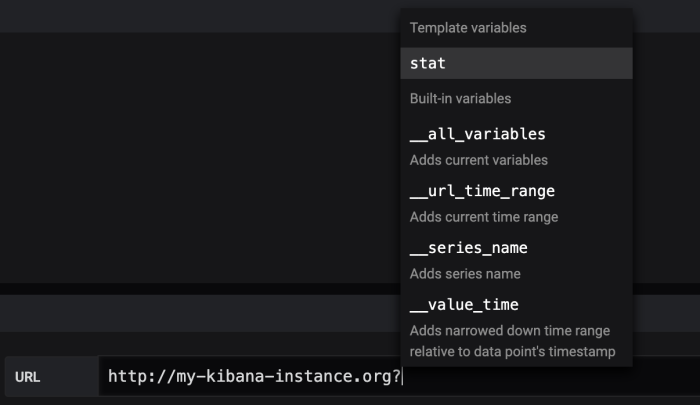Configure Data Links
You can use data link variables or data links to create links between panels.
Data link variables
You can use variables in data links to refer to series fields, labels, and values. For more information about data links, refer to Data links.
To see a list of available variables, type $ in the data link URL field to see a list of variables that you can use.
Time range panel variables
These variables allow you to include the current time range in the data link URL.
- __url_time_range - current dashboard’s time range (i.e. ?from=now-6h&to=now)
- $__from and $__to - For more information, refer to Global variables.
Series variables
Series specific variables are available under __series namespace:
- __series.name - series name to the URL
Field variables
Field-specific variables are available under __field namespace:
- __field.name - the name of the field
- __field.labels.<LABEL> - label’s value to the URL. If your label contains dots, then use __field.labels["<LABEL>"] syntax.
Value variables
Value-specific variables are available under __value namespace:
- __value.time - value’s timestamp (Unix ms epoch) to the URL (i.e. ?time=1560268814105)
- __value.raw - raw value
- __value.numeric - numeric representation of a value
- __value.text - text representation of a value
- __value.calc - calculation name if the value is result of calculation
Template variables
When linking to another dashboard that uses template variables, select variable values for whoever clicks the link.
${var-myvar:queryparam} - where var-myvar is the name of the template variable that matches one in the current dashboard that you want to use.
Variable stateResult in the created URL selected one valuevar-myvar=value1selected multiple valuesvar-myvar=value1&var-myvar=value2selected Allvar-myvar=All
If you want to add all of the current dashboard’s variables to the URL, then use ${__all_variables}.
Data links
Data links allow you to provide more granular context to your links. You can create links that include the series name or even the value under the cursor. For example, if your visualization showed four servers, you could add a data link to one or two of them.
The link itself is accessible in different ways depending on the visualization. For the Graph you need to click on a data point or line, for a panel like Stat, Gauge, or Bar Gauge you can click anywhere on the visualization to open the context menu.
You can use variables in data links to send people to a detailed dashboard with preserved data filters. For example, you could use variables to specify a time range, series, and variable selection. For more information, refer to Data link variables.
Typeahead suggestions
When creating or updating a data link, press Cmd+Space or Ctrl+Space on your keyboard to open the typeahead suggestions to more easily add variables to your URL.

Add a data link
- Hover over any part of the panel you want to which you want to add the data link to display the actions menu on the top right corner.
- Click the menu and select Edit.
- To use a keyboard shortcut to open the panel, hover over the panel and press e.
- Scroll down to the Data links section and expand it.
- Click Add link.
- Enter a Title. Title is a human-readable label for the link that will be displayed in the UI.
- Enter the URL you want to link to.
- You can even add one of the template variables defined in the dashboard. Click in the URL field and then type $ or press Ctrl+Space or Cmd+Space to see a list of available variables. By adding template variables to your panel link, the link sends the user to the right context, with the relevant variables already set. For more information, refer to Data link variables.
- If you want the link to open in a new tab, then select Open in a new tab.
- Click Save to save changes and close the window.
- Click Save in the upper right to save your changes to the dashboard.
Update a data link
- Scroll down to the Data links section, expand it, and find the link that you want to make changes to.
- Click the Edit (pencil) icon to open the Edit link window.
- Make any necessary changes.
- Click Save to save changes and close the window.
- Click Save in the upper right to save your changes to the dashboard.
Delete a data link
- Scroll down to the Data links section, expand it, and find the link that you want to delete.
- Click the X icon next to the link you want to delete.
- Click Save in the upper right to save your changes to the dashboard.